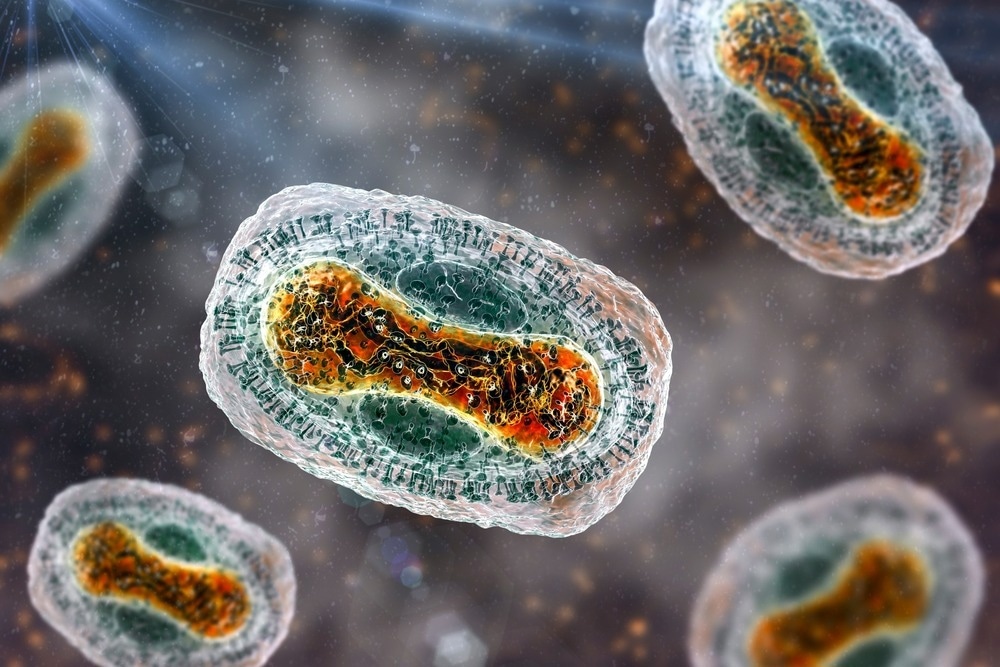In a recent review published in Environmental Microbiology, researchers provided insights into monkeypox virus (MPXV) structural characteristics, epidemiology, transmission, zoonotic reservoirs, pathogenesis, and clinical management.
 Study: Insights into the monkeypox virus: Making of another pandemic within the pandemic? Image Credit: Kateryna Kon/Shutterstock
Study: Insights into the monkeypox virus: Making of another pandemic within the pandemic? Image Credit: Kateryna Kon/Shutterstock
Background
Amid the severe acute respiratory syndrome coronavirus disease 2 (SARS-CoV-2) pandemic, the world has begun to witness the wrath of MPX, a viral illness caused by MPXV that has been endemic to Africa but has affected non-endemic nations globally in recent times. Global surveillance efforts and further research is required to trace MPX origin, identify animal reservoirs, assess biological implications, and develop anti-MPXV drugs.
About the review
In the present study, researchers collated and reviewed recent literature on several aspects of MPXV concerning the current 2022 MPX outbreak.
Structure, epidemiology, and fatality
MPX is a zoonotic and rare illness caused by MPXV, a part of the Orthopoxvirus genus and Poxviridae family, and MPXV genetically resembles the variola virus (VARV). MPX-causing virus comprises a core region with lateral bodies, double-stranded deoxyribonucleic acid (dsDNA), and a lipoprotein envelope and replicates in the cytosol of the infected host cell.
MPXV was initially discovered in Africa and Denmark in 1958 among captive monkeys and human beings in 1970 in a male infant nine months of age in the Democratic Republic of Congo (DRC). Subsequently, human MPX cases were reported in West and Central Africa [West African and Central African (or Congo Basin) genetic clades].
In recent times, MPX cases have been snowballing among non-endemic nations, and the United States (US) outbreak has been linked to the travel and import of infected Prairie dogs from Ghana. The case fatality rates (CFRs) for the Congo Basin MPXV clade and the West African MPXV clade have been reported as 11% and <1%, respectively, and the CFR for inter-human transmission has been reported as six percent.
MPX pathophysiology
MPXV has been isolated twice from animals such as sooty mangabey and rope squirrels in the Ivory Coast and DRC. The natural host of MPXV has been unknown; however, mammals such as non-human primates and rodents (dormice, Gambian pouched rats, and tree squirrels) are the most likely primary sources of MPX transmission.
MPXV can be transmitted in several ways, such as animal bites, scratches/minor cutaneous abrasions, face-to-face contact for a prolonged duration, and contact via bodily fluids such as respiratory droplets, blood, saliva, or mucosal and/or cutaneous lesion exudates and viral shedding via the fecal route. In the current outbreak, MPXV has been detected in semen, highlighting the evolving pathophysiology of MPX with sexual intercourse as a factor in MPXV transmission.
Viral entry via the nasopharyngeal, oropharyngeal, subcutaneous, intradermal, and intramuscular routes is mediated by micropinocytosis, viral endocytosis, and cell membrane fusion. MPXV replication at the inoculation activates inflammatory immune-mediated phagocytosis leading to MPXVA dissemination into blood, lymph nodes, tonsils, bone marrow, spleen, and other organs.
Enveloped virions (EV) and mature virions (MV) of MPXV regulate the release of MPXV genome and proteins into host cells, following which transcription and translation of MPXV mRNA occur, and the viral encoded with viral DNA form intracellular mature virions (IMV). IMVs wrapped with Golgi apparatus-derived membranes form intracellular enveloped virions (IEVs), that fuse with the host inner cell membrane to form cell-associated virions (CEVs), eventually released into extracellular spaces forming extracellular enveloped virions (EEV).
Clinical presentation, diagnosis, prevention, and management of MPX
MPX clinically resembles smallpox lesions but is of milder intensity. MPXV incubates for three days to two weeks (maximum three weeks), and MPX is self-limiting with symptoms for two to four weeks. Male individuals living in and proximal to forest areas are highly prone to MPX. Initially, prodromal symptoms such as myalgia, fever, headaches, and back pain occur, and after one to three days of which, the characteristic rash occurs with lymphadenopathy. The rash begins from the mouth (70%) and spreads centrifugally to involve the face (95%) and extremities, including the palm and soles (75%).
The current MPX outbreak cases have displayed the involvement of genital areas and perianal areas. Prodromal lymphadenopathy is a characteristic feature of MPX that can help distinguish MPX from smallpox and chickenpox cases. MPX is usually diagnosed from skin lesion specimens by polymerase chain reaction (PCR) tests. Serological tests are not recommended for MPX since most orthopoxviruses have demonstrated serological cross-reactivity.
At present, no specific US FDA (Food and Drug Administration)-approved therapeutic agents against MPX are available; however antiviral medications including cidofovir, tecovirimat, and brincidofovir have been effective in MPX cases. In addition, vaccinia immune globulin intravenous (VIGIV) has been used, and vaccination against smallpox (such as JNNEOS and ACAM 2000) has demonstrated 85% efficacy in MPX prevention.
Supportive measures include fluid maintenance, abstinence from sex for eight weeks post recovery, avoiding zoonotic contact, preventing bush meat consumption, regular handwashing, and isolating infected persons with increasing MPX awareness and education programs.
Conclusion
To conclude, MPX cases have been snowballing across the globe due to the genetic evolution of MPXV with mutations enhancing the transmissibility, virulence, and immune-evasiveness of the virus. The geographic expansion of MPX warrants global health authorities to enforce appropriate MPX preventive measures and increase funding to facilitate more diagnostic testing and research on the evolutionary characteristics of MPXV to decrease the health burden of MPX.